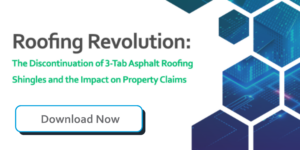Let’s Talk 3-Tab Transition Strategies with an itel Expert, Jacob Piazza


In recent years, there has been a notable transition away from 3-tab asphalt shingles in the roofing industry. This shift has been driven by several factors including evolving consumer preferences, and increased demand for more durable and energy-efficient roofing materials.
To delve deeper into this roofing revolution and understand its impact on property claims, consider downloading itel’s white paper titled “Roofing Revolution: The Discontinuation of 3-Tab Asphalt Roofing Shingles and the Impact on Property Claims.” This comprehensive resource offers insights into the reasons behind the discontinuation of 3-tab asphalt shingles, the benefits of alternative roofing materials, and the implications for property owners and insurance claims.
To discuss some of the data in the whitepaper and the overall impact of this trend on the industry, we sat down with Jacob Piazza, itel’s Director of Roofing Solutions. Jacob is a former owner/operator of a roofing company and serves on the board of the Florida Roofing, Sheet Metal, and Air Conditioning Contractors Association (FRSA).
Understanding the Transition: Exploring the Discontinuation of 3-Tab Asphalt Shingles and Its Implications
Q: What factors are leading to some manufacturers discontinuing 3-tab asphalt roofing shingles?
Jacob: I’d say that a lot of it started in COVID. Manufacturers reduced the lines and colors they were running. It seems that they could increase efficiency by having fewer colors and lines and still sell the same amount or more of the product. Although cost effective, many 3-tab shingles are less resistant to high wind and extreme weather conditions. So, there has also been a push in the market to purchase better-quality materials. In response to this demand, many roofing manufacturers have started to develop new and improved products that are more durable and reliable in harsh weather conditions. Lastly, changes in the labor market. It takes a different set of skill levels to install a 3-tab shingle because you’ve got to install it on what’s called a bricklayer by aligning the watermarks. By simplifying the variety of asphalt shingles in the market, roofers are also able to find efficiencies in the installation process.
Q: Can you elaborate on the significance of itel’s data showing that 40% of damaged asphalt roofs have 3-tab shingles?
Jacob: Absolutely, the significance of itel’s data revealing that 40% of damaged asphalt roofs feature 3-tab shingles is multifaceted and speaks to several critical aspects of the roofing industry landscape. Firstly, it highlights the past popularity of 3-tab shingles in the roofing market. Newly installed roofs use 3-tab shingles far less than 40% of the time, but their historical popularity means that they are more common on existing roofs in the U.S. overall.
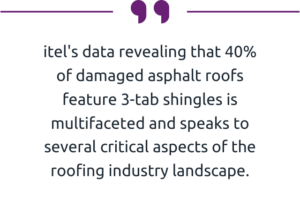
Furthermore, itel’s data brings to light the potential challenges that property owners may encounter if manufacturers discontinue certain lines or colors of 3-tab shingles. This could lead to a reduction in the options available for repairs or replacements of damaged roofs. With fewer options to match existing shingles, property owners may find it challenging to conduct targeted repairs, increasing the likelihood of needing total roof replacements. This limitation could significantly impact the property insurance industry, threatening to make repairs less feasible and total replacements more common.
Importantly, itel’s data highlights the need for proactive approaches to roof maintenance and replacement. With a significant portion of damaged roofs being composed of 3-tab shingles, property owners and roofing professionals must be proactive in recognizing the potential need for replacement, even if the shingles have not reached their full life expectancy. By acknowledging the prevalence of 3-tab shingles in damaged roofs, stakeholders can better anticipate and prepare for the challenges associated with maintaining and repairing roofs now or in the near future.
Q: How might the discontinuation of 3-tab shingles impact repairability programs for property insurers
Jacob: Yeah, discontinuing 3-tab shingles will definitely complicate the matching process for damaged roofs. With fewer options due to discontinuations, it becomes increasingly challenging for repair professionals to find appropriate matches for existing shingles. This poses several issues, including potential aesthetic discrepancies and functional problems. Aesthetic concerns because homeowners typically prefer to maintain the original color scheme of their roofs to ensure uniformity as shingles fade over time. However, without access to the original shingle colors, repair professionals may struggle to find suitable replacements, leading to mismatches that become more apparent as the roof ages. Conversely, when the original shingles were still available, the aesthetics of repairs would typically improve over time as the new shingles fade closer to the original color over time, with the majority of the fade occurring in the early years of life.
Functional problems because using different-size shingles can potentially compromise the roof’s water tightness and impact its overall durability. Mismatched shingles may not seal properly, leaving the roof vulnerable to leaks and moisture infiltration.
Proactive Solutions: Navigating the Transition Away from 3-Tab Shingles with itel
Q: Can you provide guidance for transitioning away from 3-tab asphalt shingles for carriers and other stakeholders?
Jacob: Certainly, at itel, we have taken proactive steps to address the potential impact of 3-tab shingle discontinuations on repair programs. One initiative involves bolstering our Discontinued Materials Inventory (DMI) warehouse with a substantial inventory of 3-tab shingles. By stocking up on these materials before they are discontinued, we aim to provide carriers, roofers, and homeowners with the necessary resources to facilitate small repairs for damaged roofs when appropriate. Our inventory is meticulously managed to ensure availability over an extended period. Our aim is to offer a buffer period during which stakeholders can transition to alternative roofing materials without immediate pressure for total replacements, thereby promoting long-term planning and sustainability in the industry.
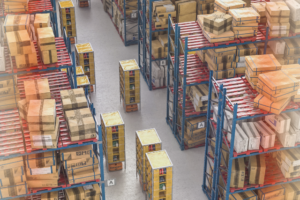
Although we aim to help our partners with minor repairs using our available inventory, we understand that some situations, like significant damage or unavailability of specific materials in our inventory, may require a complete roof replacement. In these cases, our partners may need to pivot quickly to alternative solutions.
While we strive to support minor repairs with our inventory, we recognize that significant damage or material unavailability might necessitate a complete roof replacement. In such scenarios, itel is committed to facilitating a seamless shift to alternative solutions. This involves refining repair and replacement strategies and collaborating with reputable suppliers and contractors to ensure access to high-quality products and services. By working together, we support a collective effort to navigate the industry’s transition and maintain the highest standards of service and reliability.
Q: What are the anticipated challenges in implementing sustainable roofing alternatives, and how might they be addressed?
Jacob: One significant challenge I have already noticed on the horizon is in navigating regulatory requirements and municipal mandates regarding impact resistance standards. So, when you talk about sustainable roofing alternatives, with all the hail damage and the roofs that have been replaced in the United States in the last several years based on weather, one of your big sustainable alternatives is a class four impact-resistant roof. While class four impact-resistant roofs are increasingly recognized as sustainable alternatives due to their ability to withstand damage, some municipalities have actually mandated these standards for all roof replacements, regardless of material. This presents a challenge for homeowners and contractors, who may face additional costs and logistical hurdles in meeting these requirements.
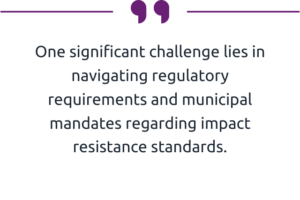
To tackle the challenges at hand, we need to take a comprehensive approach. Initially, stakeholders need to communicate with regulatory agencies and promote rational and adaptable policies that balance sustainability targets and practical requirements. Joint efforts to educate policymakers and homeowners about the advantages and limitations of various impact resistance standards can be beneficial in encouraging well-informed decision-making.
Additionally, manufacturers and contractors are crucial in developing and promoting sustainable roofing alternatives that meet or exceed regulatory requirements while offering cost-effective solutions. Investing in research and development to enhance the durability and performance of roofing materials can pave the way for the broader adoption of sustainable alternatives.
Shaping the Future: Trends and Innovations in the Roofing Industry
Q: How do you envision the future of the roofing industry being shaped by these changes?
Jacob: The roofing industry is experiencing a major shift. Architectural shingles are becoming the preferred roofing solution due to their superior durability, aesthetic appeal, and performance compared to traditional 3-tab varieties. Furthermore, alternative roofing materials, such as metal roofing, are gaining significant market share year after year, reflecting a broader trend toward diversification in the roofing industry.
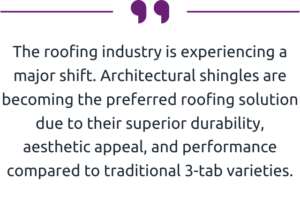
Looking ahead, the future of the roofing industry will be shaped by communication and collaboration. As architectural shingles continue to become the norm, it is crucial for manufacturers, contractors, insurers, and homeowners to engage in open dialogue about the benefits and limitations of different roofing materials.
I also want to mention advancements in technology and innovation. From the development of more sustainable and eco-friendly roofing materials to the adoption of digital tools for project management and communication, technology will play an increasingly integral role in streamlining processes and improving efficiency across the roofing supply chain, impacting the entire insurance ecosystem.
Embracing Change: itel’s Vision for the Future
Through a series of proactive measures and strategic initiatives, itel is actively assisting stakeholders in adapting to the discontinuation of 3-tab shingles. These measures include bolstering our inventory of discontinued shingles to support repair programs, investing in new data-driven tools, and promoting collaboration among industry professionals.
By sustaining a culture of collaboration, embracing new technologies and data-driven insights, and prioritizing customer satisfaction, we envision a thriving property insurance industry that can navigate an era of change and uncertainty with confidence.
